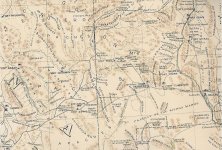Old Bookaroo
Silver Member
- Dec 4, 2008
- 4,318
- 3,510
Lieut. Col. William Emory's "Notes" and The Lost Adams Diggings
Many bibliographies of The Lost Adams Diggings include Lieut. Col. W.H. Emory's Notes of a Military Reconnaissance from Fort Leavenworth, Missouri, to San Diego, California... Thirtieth Congress - First Session, Ex. Doc. No. 41 (Washington, DC: 1848).
One reason, of course, is that many lost mine authors are content to copy the work of previous scribes, rather than complete actual research.
My question: What does this report have to do with the Lost Adams Diggings?
From page 66:
"As the story goes, the Prierte river flows down from the mountains, freighted with gold. Its sands are said to be full of the precious metal. A few adventurers, who ascended the river hunting beaver, washed the sands at night when they halted, and were richly rewarded. Tempted by their success, they made a second trip, and were attacked, and most of them killed by the Indians. My authority for this statement is Londreau, who, though an illiterate man, is truthful."
http://books.google.com/books?id=gg...&resnum=3&ved=0CCEQ6AEwAg#v=onepage&q&f=false
Here's a link to the famous map included in this report. Follow Lieut. Col. emory's route and locate October 26th.
http://www.davidrumsey.com/luna/ser...0~180024:-Military-Reconnaissance-Of-The-Ark#
As is often the case, it appears the source for this is John D. Mitchell. In Lost Mines of the Great Southwest; Including Stories of Hidden Treasures (Phoenix, Arizona: 1933), he quotes Lieut. Col. Emory's report. The same information may be found in Mitchell's Desert Magazine article "Lost Adams Diggings" (July, 1941). Eugene L. Conrotto told it again in Lost Desert Bonanzas (Palm Desert, California: 1963).
It should be noted Mr. Mitchell named the river the "Prieto" and the teller of the tale "Landreau."
How is this account connected to The Lost Adams Diggings? Lieut. Col. Emory's account is from October 1848 - as Mr. Conrotto correctly pointed out, well before the generally agreed upon time of Adams' visiting and then losing his Diggings.
Good luck to all,
~The Old Bookaroo
PS: In his book, Mr. Mitchelll quotes a letter from Robert T, Emmet, 2nd Lt. of the Ninth Cav., USA. It was dated March 5, 1882. It would be quite interesting to read that entire letter - but that's another story...
Many bibliographies of The Lost Adams Diggings include Lieut. Col. W.H. Emory's Notes of a Military Reconnaissance from Fort Leavenworth, Missouri, to San Diego, California... Thirtieth Congress - First Session, Ex. Doc. No. 41 (Washington, DC: 1848).
One reason, of course, is that many lost mine authors are content to copy the work of previous scribes, rather than complete actual research.
My question: What does this report have to do with the Lost Adams Diggings?
From page 66:
"As the story goes, the Prierte river flows down from the mountains, freighted with gold. Its sands are said to be full of the precious metal. A few adventurers, who ascended the river hunting beaver, washed the sands at night when they halted, and were richly rewarded. Tempted by their success, they made a second trip, and were attacked, and most of them killed by the Indians. My authority for this statement is Londreau, who, though an illiterate man, is truthful."
http://books.google.com/books?id=gg...&resnum=3&ved=0CCEQ6AEwAg#v=onepage&q&f=false
Here's a link to the famous map included in this report. Follow Lieut. Col. emory's route and locate October 26th.
http://www.davidrumsey.com/luna/ser...0~180024:-Military-Reconnaissance-Of-The-Ark#
As is often the case, it appears the source for this is John D. Mitchell. In Lost Mines of the Great Southwest; Including Stories of Hidden Treasures (Phoenix, Arizona: 1933), he quotes Lieut. Col. Emory's report. The same information may be found in Mitchell's Desert Magazine article "Lost Adams Diggings" (July, 1941). Eugene L. Conrotto told it again in Lost Desert Bonanzas (Palm Desert, California: 1963).
It should be noted Mr. Mitchell named the river the "Prieto" and the teller of the tale "Landreau."
How is this account connected to The Lost Adams Diggings? Lieut. Col. Emory's account is from October 1848 - as Mr. Conrotto correctly pointed out, well before the generally agreed upon time of Adams' visiting and then losing his Diggings.
Good luck to all,
~The Old Bookaroo
PS: In his book, Mr. Mitchelll quotes a letter from Robert T, Emmet, 2nd Lt. of the Ninth Cav., USA. It was dated March 5, 1882. It would be quite interesting to read that entire letter - but that's another story...








